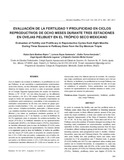Mostrar el registro sencillo del ítem
Evaluación de la fertilidad y prolificidad en ciclos reproductivos de ocho meses durante tres estaciones en ovejas pelibuey en el trópico seco mexicano
| dc.rights.license | http://creativecommons.org/licenses/by-nc-sa/3.0/ve/ | |
| dc.contributor.author | Martínez R., Rubén D. | |
| dc.contributor.author | Reyna, Lorenzo | |
| dc.contributor.author | Torres Hernández, Glafiro | |
| dc.contributor.author | Mastache L., Ángel A. | |
| dc.contributor.author | Michel A., Alejandro C. | |
| dc.date.accessioned | 2011-09-29T18:24:29Z | |
| dc.date.available | 2011-09-29T18:24:29Z | |
| dc.date.issued | 2011-09-29T18:24:29Z | |
| dc.identifier.issn | 0798-2259 | es_VE |
| dc.identifier.uri | http://www.saber.ula.ve/handle/123456789/33791 | |
| dc.description.abstract | Con el objetivo de evaluar la fertilidad y la prolificidad en ovejas Pelibuey, al ser sometidas a apareamientos estacionales, cada ocho meses, en tres diferentes épocas del año bajo condiciones de trópico seco, se llevó a cabo el presente estudio en el Colegio Superior Agropecuario del estado de Guerrero, México, a 18° 15´26´´ LN, con clima Aw0(w)(i´) g. Se utilizaron tres machos y de 90 a 104 ovejas Pelibuey (el número varió según la fecha del apareamiento o empadre) mantenidas en condiciones semi-extensivas y sometidas a tres empadres estacionales consecutivos de 60 días con monta en grupo (proporción macho:hembra 1:32), los cuales se realizaron cada ocho meses: Octubre-noviembre, junio-julio y febrero-marzo. Las variables medidas fueron tasa de fertilidad e índice de prolificidad y los datos se analizaron mediante pruebas de “Z” para proporciones y de ”t” de Student. La tasa de fertilidad de 93,7% registrada para el empadre de octubre-noviembre, fue mayor (P<0,05) a la fertilidad obtenida en los apareamientos de junio-julio (84,6%) y de febrero-marzo (75,5%); detectándose también diferencia para la tasa de fertilidad (P<0,05) entre estas dos últimas épocas de apareamiento. De manera similar a lo registrado para la tasa de fertilidad, el índice de prolificidad fue mayor (P<0,05) para el empadre de octubre-noviembre (1,53 ± 0,06 crías por parto), comparado con el índice observado en los apareamientos de junio-julio (1,38 ± 0,05 crías por parto) y de febrero-marzo (1,23 ± 0,05 crías por parto); encontrándose también diferencia (P< 0,05) en el tamaño de camada entre estas dos últimas épocas de montas. Se concluye que, bajo condiciones semi-extensivas del trópico seco del sur de México, la fertilidad y la prolificidad en la oveja Pelibuey son afectadas significativamente por la estación del año en la que se establece el empadre. Estos parámetros son mayores cuando los apareamientos se realizan durante el otoño y menores para las montas de primavera. | es_VE |
| dc.language.iso | es | es_VE |
| dc.rights | info:eu-repo/semantics/openAccess | |
| dc.subject | Empadre (apareamiento) | es_VE |
| dc.subject | Fertilidad | es_VE |
| dc.subject | Prolificidad | es_VE |
| dc.subject | Oveja pelibuey | es_VE |
| dc.title | Evaluación de la fertilidad y prolificidad en ciclos reproductivos de ocho meses durante tres estaciones en ovejas pelibuey en el trópico seco mexicano | es_VE |
| dc.title.alternative | Evaluation of fertility and prolificacy in reproductive cycles each eight months during three seasons in pelibuey ewes from the dry mexican tropic | es_VE |
| dc.type | info:eu-repo/semantics/article | |
| dc.description.abstract1 | In order to evaluate the fertility rate and the prolificity index in Pelibuey ewes when they are submitted to breeding seasons each eight mounts, in three different periods around of the year under dry tropic conditions, a study was carried out at the Colegio Superior Agropecuario of the State of Guerrero, México at 18° 15´26´´ NL in Aw0 (w)(i´)g clime. Three rams and 90 to 104 Pelibuey ewes (the number of females changed according to the breeding date) maintained en semi-extensive conditions were submitted to three consecutive breeding seasons from 60 days of duration, utilized mating in group (male:female rate 1:32). The breeding seasons were programmed each 8 months: October- November, June-July and February-March. The variables evaluated were fertility rate and prolificacy index and dates were evaluated by Z for proportions and T Student tests. A greater (P<0.05) fertility rate (93.7%) was registered when mating were carried out in October-November, in comparison to June-July breeding season fertility rate (84.6%), at the same time, fertility rate was greater (P<0.05) for February-March breeding season (75.5%). Similarly, prolificacy index was higher (P<0.05) for October-November breeding season (1.53 ± 0.06 kids), than for June-July (1.38 ± 0.05 kids) and February-March mating (1.23 ± 0.05 kids). Under semi-extensive dry tropic conditions of Southern Mexico, the fertility and prolificacy in Pelibuey ewes were significantly affected for the season of the year when the mating is established. These parameters were higher when the breeding season was programmed in the Autumn, and lower for breeding carried out during the Spring. | es_VE |
| dc.description.colacion | 383-387 | es_VE |
| dc.description.email | rubendariomr1@prodigy.net.mx | es_VE |
| dc.description.frecuencia | Bimestral | es_VE |
| dc.identifier.depositolegal | 199102ZU46 | es_VE |
| dc.subject.institucion | Universidad del Zulia (LUZ) | es_VE |
| dc.subject.institucion | Universidad de Los Andes (ULA) | es_VE |
| dc.subject.keywords | Breeding season | es_VE |
| dc.subject.keywords | Fertility | es_VE |
| dc.subject.keywords | Prolificacy | es_VE |
| dc.subject.keywords | Pelibuey ewe | es_VE |
| dc.subject.publicacionelectronica | Revista Científica | es_VE |
| dc.subject.seccion | Revista Científica: Producción Animal | es_VE |
| dc.subject.thematiccategory | Medio Ambiente | es_VE |
| dc.subject.tipo | Revistas | es_VE |
| dc.type.media | Texto | es_VE |
Ficheros en el ítem
Este ítem aparece en la(s) siguiente(s) colección(ones)
-
Revista Científica - 2011- Vol. XXI - No. 005
Septiembre - Octubre 2011


